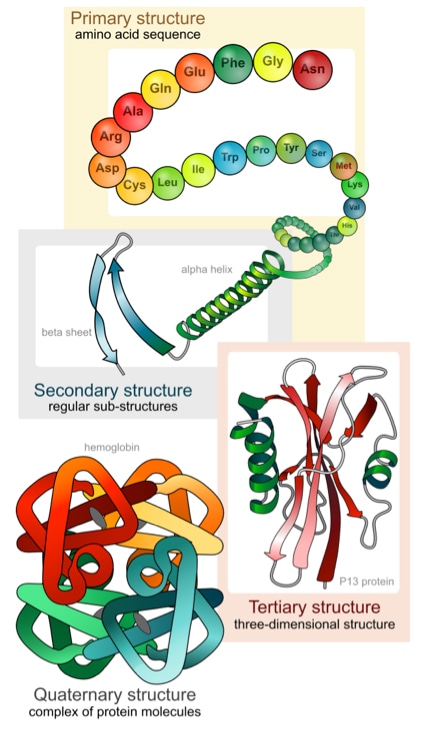Unlocking the Secrets of Protein Structures
The intricate configuration of amino acid atoms within a protein molecule, known as its protein structure, holds the key to its functionality. Proteins, composed of amino acid sequences, serve as the building blocks of this molecular puzzle. Each individual amino acid, also termed a residue, contributes to the polymer's repetitive units. As amino acids undergo condensation reactions, losing a water molecule in each step, they form peptide bonds and link together. While chains containing fewer than 30 amino acids are typically referred to as peptides, those surpassing this threshold earn the title of proteins. To execute their vital biological roles, proteins spontaneously fold into distinct spatial conformations, driven by an array of non-covalent interactions, including Van der Waals forces, hydrophobic interactions, hydrogen bonding, and ionic attractions. Delving into proteins at a molecular level necessitates an understanding of their three-dimensional structures. This quest falls under the domain of structural biology, employing methodologies such as NMR spectroscopy and X-ray crystallography to decipher protein architectures.
What Are The 4 Different Types Of Protein Structure?
Spanning amino acid counts ranging from a few dozen to thousands, protein structures vary widely in size. Categorized as nanoparticles due to their dimensions (1-100 nm), proteins can further assemble into extensive aggregates. For instance, microfilaments arise from the assembly of thousands of actin subunits. Dynamic structural changes are inherent to proteins' functional roles. Distinct conformational isomers, often referred to as transitions, showcase alternate structures within the same protein molecule. The interplay between these conformations is characterized as conformational changes. A protein's structure manifests across four hierarchical levels: primary structure, secondary structure, tertiary structure, and quaternary structure.
Primary Structure: The primary structure denotes the uninterrupted sequence of amino acids comprising a protein chain. The orchestration of this sequence is underpinned by the genetic code encrypted within DNA. Remarkably, the precise arrangement of amino acids exerts commanding influence over both the distinctive structure assumed by the protein and the distinctive functional role it undertakes.
Secondary Structure: Within the precinct of secondary structure, focus is directed towards the localized folding patterns that materialize within discrete segments of the protein sequence. Among these, the alpha-helix and beta-sheet configurations hold prominence. An alpha-helix entails a coiled, right-handed disposition of the peptide chain, while beta-sheets encompass elongated strands that entwine to form a sheet-like architecture.
Tertiary Structure: The tertiary structure encompasses the all-encompassing three-dimensional arrangement of the complete protein entity. This intricate configuration emerges as a consequence of interactions between amino acid side chains, often positioned distantly along the linear sequence. The spectrum of these interactions encompasses hydrogen bonds, disulfide bonds, hydrophobic contacts, and a compendium of other forces.
Quaternary Structure: Quaternary structure pivots towards the organization of diverse protein subunits, when a protein comprises multiple polypeptide chains. These subunits can assume uniformity or distinction, their positioning and interactions synergistically contributing to the functional attributes of the overarching protein complex.
Collectively, these discrete strata of protein structure coalesce in unison, decisively molding the final geometry, stability, and utilitarian capacities of proteins within the intricate landscape of biological milieu.

How Do We Analyze The Protein Structure?
Embedded within the core of protein structure bioinformatics analysis is a synergistic amalgamation of disciplines encompassing biology, computer science, and mathematics. Amino acids, as the elemental constituents underpinning protein formation, synergize through intricate interplays, ultimately culminating in the origination of distinctive folded conformations. These conformational ensembles, spanning from primary to quaternary tiers, wield pivotal influence over the mechanistic underpinnings governing the operational scope of proteins within the milieu of living organisms.
Navigating the intricate expanse of protein realms, where form seamlessly orchestrates function, necessitates the adroit deployment of pioneering analytical methodologies. The paradigm of protein structure bioinformatics analysis emerges as an eminent conduit, uniquely equipped to divulge the concealed architectural nuances intrinsic to these foundational biomolecules.
In the vanguard of this pursuit, Creative Proteomics stands as a purveyor of distinction, unveiling its dedicated Protein Structure Bioinformatics Analysis Service. With resolute commitment, this service is poised to unmask the enigmas enshrouded within these intricate molecular assemblages.
The Essence of Creative Proteomics' Protein Structure Bioinformatics Analysis Service
Within the realm of protein structure bioinformatics analysis, Creative Proteomics presents an assortment of state-of-the-art solutions meticulously tailored to unravel the intricacies inherent in protein architectures:
Advanced Structural Prediction: Our proficient team leverages intricate algorithms to anticipate secondary and tertiary protein structures, thereby furnishing invaluable insights into the underlying folding patterns.
Exemplary Homology Modeling: Through adept application of comparative modeling methodologies, we construct precise three-dimensional protein models, drawing parallels to established structures to facilitate a heightened comprehension of their functionalities.
Virtual Molecular Docking: Via simulations centered on molecular docking, we delve into the interplay between proteins and other molecular entities, thereby illuminating the mechanisms of binding and the potential therapeutic prospects therein.
Dynamic Simulations: Unveiling the temporal evolution of protein behavior via molecular dynamics simulations, we lay bare pivotal intricacies concerning stability, flexibility, and interactions.
Functional Annotation: Our exploration extends to the functional dimensions of protein structures, as we meticulously annotate salient attributes that furnish discernment into their pivotal roles within cellular processes.
Protein Structure Features Analysis: Delve into intricate protein features to gain insights into their roles and implications.




